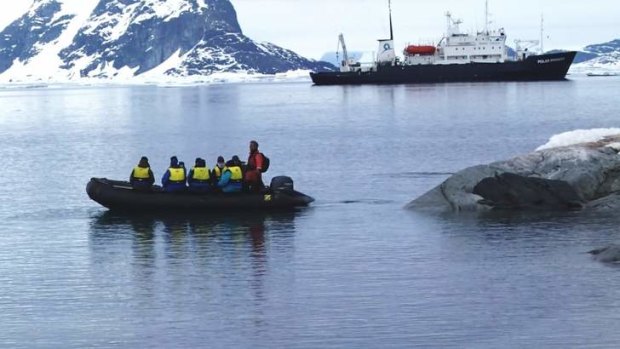
Raw beauty: a Zodiac with the Polar Pioneer in the background.Credit: Steve Coleman
Visiting Antarctica is invariably described as a life-changing experience. Lynne Whiley heads there on a 10-day expedition and discovers why.
Predator or prey? No. Windbreak? Yes! And with quiet heaves and fore-flipper shuffles, a young elephant seal moves across the sand, places its bulk against the thigh to effect a gentle, slow-motion tackle of sorts, snuggles up and calmly closes its luminous liquid-black eyes. Nighty night.
A dozen metres away, a 20-strong herd of adult seals rests in a languid collision of fur, the largest male weighing about 3000 kilograms, while younger males play-fight offshore in frigid shallows. At a penguin rookery on a nearby basalt outcrop, newborn gentoo chicks are being picked off by predator skua birds.
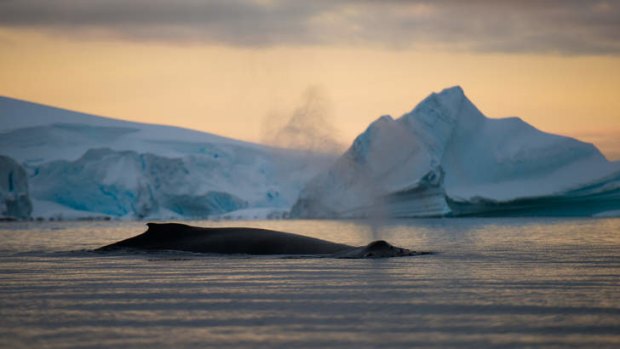
Whale at sunset.Credit: David Coleman
I'm on my back on gritty sand littered with bones and can't see the expedition leaders I'm with, but I can imagine receiving shirty letters from Antarctic authorities and wildlife experts for not staying at least five metres from the wildlife. "Human windbreak for an Antarctic seal? Had my back turned, watching killer birds, didn't see it coming," is a feeble defence despite its being an accurate account of events at Elephant Point on Livingston Island in the Antarctic Peninsula's South Shetland Islands.
This isn't the Antarctic of ships frozen in sea ice needing rescue; we've sailed from the southern tip of South America, the shortest crossing to the Antarctic continent, and are hundreds of nautical miles from where those international events unfold.
Yes, our ship, the ice-strengthened Polar Pioneer, has a Russian crew and on occasion the vessel crushes its way through sea ice. But this is not a scientific mission to the frozen wilderness, it's a 10-day life-changing journey with Australia's Aurora Expeditions.
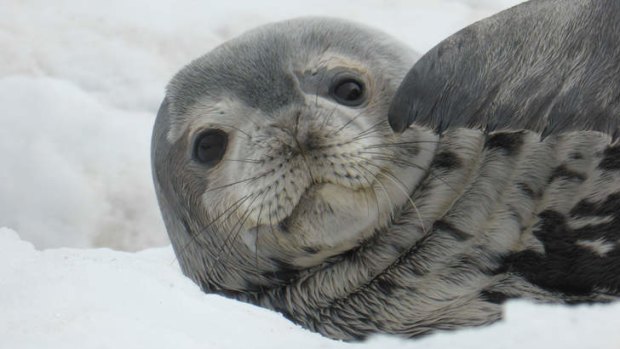
A seal pup.Credit: Jeff Woodham
Nothing can prepare first-time travellers for the Antarctic's outsize landscapes, protean light and pragmatic wildlife. Mountains and glaciers seem gouged, chiselled or hurled into being. Icebergs can seem like colossal textured art works; some battered, pock-marked or patterned, others a look-at-me riot of creamy-smooth curves pulsating with trance-inducing shades of aquamarine.
Passengers disembark the Polar Pioneer mother ship to zip about in Zodiac inflatables or kayaks, landing and walking on ancient hills, among wildlife or the ruins of abandoned man-made bases.
Some passengers camp on the ice, swim or bum-slide down mountains of snow. Others are in heaven watching Adelie, chinstrap and gentoo penguins, seals, whales and albatross.
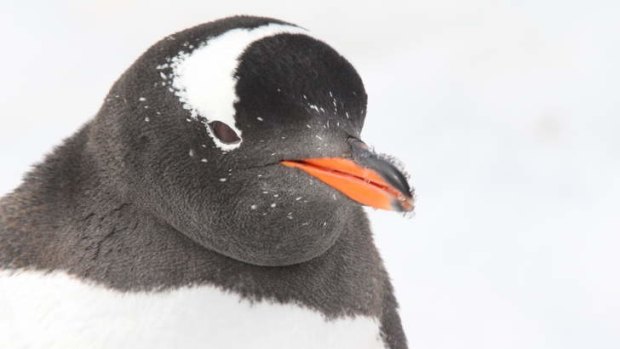
A gentoo penguin.Credit: John Noel
It's impossible not to be surprised and delighted by the drama of landscapes and the ways of wildlife - on land, in the water and in the air. In summer there's no dark night sky shutting down the show, either.
THE VESSEL
The Polar Pioneer's bridge is open to passengers 24/7, an extraordinary privilege few captains of commercial ships offer their guests. When the first officer is glued to the radar screen, calling positions to the helmsman as they navigate the skinny treachery of the Lemaire Channel, passengers are silent witnesses. When whales are spotted, the call goes out and people race to the bridge for bird's-eye views.
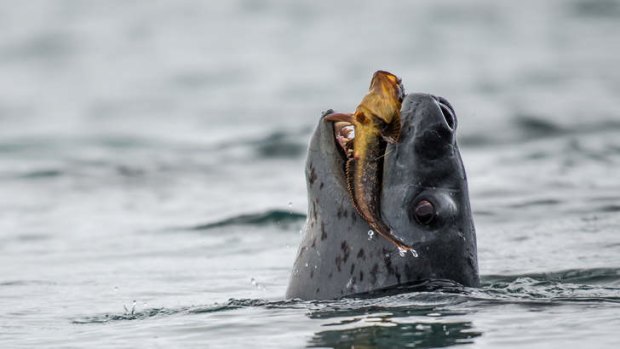
A seal with its catch.Credit: David Coleman
On a back wall is a collector's item, an old steel-grey, Russian ship's phone connecting bridge and engine room. "Hotline to the Kremlin," the officers joke.
From the bridge, passengers watch towering glacial walls come into view, storms swell and penguins swimming in formation. We eavesdrop on communications and learn a little Russian.
The 54-passenger vessel is not a flash cruise ship but its design means all passenger cabins have portholes so there's no such thing as an "inside" (aka windowless) berth. In Antarctica, it's all about what's out there, even while in bed, snuggling in white linens with soft pillows. A pair of inventive chefs produces first-rate meals, the bar works on an honour system, there's a ship's doctor, small sauna and Aurora's expedition team, lead by Don, Rosy and Nigel, are highly experienced.
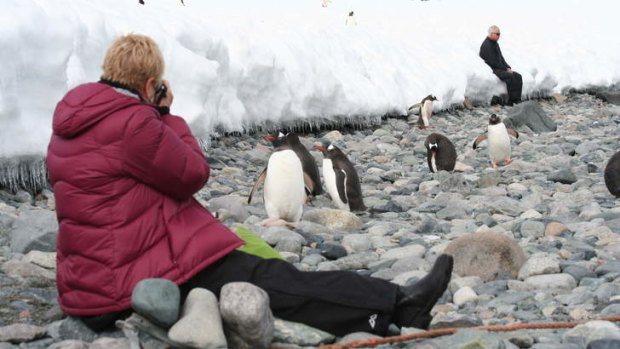
Trinity Island penguins.Credit: Allan Braun
Being a small ship, the bar doubles as a library and the lecture room is a squeeze, but there are no long queues when boarding a Zodiac - a bonus that passengers of larger ships who have had to wait an age to disembark in a cold climate will fully appreciate.
THE PASSENGERS
A diverse mix of Australians, Americans, Canadians and Brits is aboard, ranging in age from the mid-20s upwards.
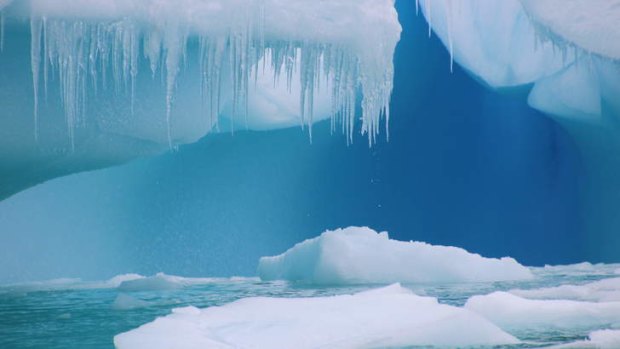
Cierva Cove.Credit: Robert Kelly
A young physiotherapist and her mother have come from Perth to undertake this ice adventure; a Sydney vet and her adult daughter likewise. Several more cabins are occupied by a parent and young adult; generations travelling together in a shared curiosity to explore this precious polar environment and be transformed with new experiences.
Australian passengers tell me they booked the cruise, then added other interests - from trekking in Chilean Patagonia to dancing in Buenos Aires to seeing Brazil's Iguacu Falls and Amazon regions - flying from Australia with LAN Air to Chile, then using the airline's South American flights network.
Some passengers have been on the continent for months; others are to explore Central and South America after this cruise and the ship's dining room and bar become lively places where travel experiences are shared.
THE ITINERARY
Ushuaia, a windy port at Argentina's southern tip surrounded by Tierra del Fuego National Park, is where we board the Polar Pioneer, sailing out through the Beagle Channel, with Chile's Cape Horn to our right.
Once out of the Beagle, ships face the challenging Drake Passage, a rowdy body of water where Pacific and Atlantic oceans and Antarctic currents meet. The ship has stabilisers and we sit on 10-11 knots while passengers adapt to the turbulence. No one reports being thrown from their bed so our Drake crossing is considered a reasonable one by officers, crew and expedition team.
There's a lot to learn during the crossing: about Antarctica; safety onboard, in kayaks and onshore; and about krill - a tiny crustacean vital to the Antarctic food chain. We vacuum our oversnow gear and choose gumboots from the ship's supplies.
Passengers will walk their boots through tubs of disinfectant before and after each landing, as Nigel, the onboard naturalist, explains that penguins visit just one Antarctic colony whereas we'll be exploring several - preferably without leaving our bacteria behind.
On D'Hainaut Island in Mikkelsen Harbour on the peninsula's western side, we go ashore to explore remnants of human habitation: a refuge; a whale jaw and other bones visible in the snow, old boat planks nearby.
Here, and at rookeries further south, we see nesting penguins, the males painstakingly gathering small stones for their partner's nest, often by deftly stealing from adjacent nests.
Later that night, after a splendid dinner of salmon and risotto, we board the Zodiacs again to cruise ice cliffs, spot for whales, zip among sheets of brash ice and loiter near icebergs, quietly watching the movement of waves and play of light on diamond-like surfaces until the boom-crack of a glacier on the move interrupts the silence. All the world a stage.
Further south, in Gerlache Strait, a gorgeous blue-sky day emerges and the Polar Pioneer seems to purr along a flat sea. Later, when whales are spotted, the bridge puts the vessel into a slow-turning pattern and we watch a mother and calf to starboard while other adults breach alongside the ship.
"We'll just stay here as long as we like," says Don as passengers move between the bridge, bow and topside flying bridge to watch, film, photograph and enjoy.
Later, we gather in the ship's bar to view one another's photographs, several of which are published on these pages including some taken by a US-based professional photographer (havecamerawilltravel.com) who was cruising with his father. A feature of Aurora's journeys is that guests are invited to contribute their best photos to the ship's log and keepsake.
On days of sunshine and dark skies alike, the ship's chefs bake pastries and cakes and have hot drinks at the ready as an antidote to the region's biting, cold winds.
At Port Lockroy in the Palmer Archipelago, a port used by whaling ships and British scientists, we visit a museum and post office run by the United Kingdom Antarctic Heritage Trust. Further south, the Polar Pioneer drops anchor off Galindez in the Argentine Islands and passengers disembark into Zodiacs and kayaks to visit Vernadsky, a Ukrainian research base and summer home to experts in seismology, meteorology, glaciology and ecology.
The Ukrainians bought the base, formerly known as Faraday, from the British, whose scientists are famous for recording the data that led to the discovery of the hole in the ozone layer.
The Ukrainians tend a bar, housed in the roof of a building, where a meteorologist serves me a glass of home-made vodka and a plate of nibbles. It's possibly the southernmost public bar in the world and has views out across fuel tanks on which palm trees are painted.
This outpost of science and shot-glass hospitality is our furthest point south on this expedition and from here, the Polar Pioneer turns and heads north, stopping at jaw-dropping bays and waterways until we reach King George Island, at the tip of the Antarctic Peninsula.
Research stations belonging to 11 countries, including Argentina and Chile, China and the US, are dotted across King George Island, and we disembark on the island's Fildes Peninsula, walk to a small airstrip and hand back the gumboots we have lived in outdoors for the past 10 days.
From the air, the white world begins to disappear from view and, soon enough, mainland colours arrive as we prepare to land at Punta Arenas, in Chile's far south.
The familiar greens and browns of the settled human landscape seem ordinary after immersion in the startling shapes, textures and colours of such an enervating, demanding wilderness. No wonder Antarctica is a magnet for scientists and adventure cruise travellers alike.
The writer travelled courtesy of Aurora Expeditions and Lan Airlines.
TRIP NOTES
GETTING THERE
LAN Airlines has a fare to Ushuaia for about $2745 low-season return Sydney inc. tax. Fly to Santiago (about 15hr via Auckland), then to Buenos Aires (2hr 5min) and Ushuaia (3hr 45min). Melbourne passengers pay about $100 more. Aurora Expeditions passengers can board in Chile or Argentina.
See lan.com.
CRUISING THERE
Aurora Expeditions' Polar Pioneer cruises are November-March. Passengers can cruise roundtrip from the South American mainland to the Antarctic Peninsula or combine a fly/sail cruise from or to Chile's Santiago or Punta Arenas.
A 12-day Spirit of Antarctica cruise, December 6, or January 20, from Ushuaia, Argentina, and returning via Chile's Puerto Williams, is priced from $US8700 ($9690) a person, twin share. Price includes flight back to Punta Arenas.
Aurora's 20-day In Shackleton's Footsteps expedition, which also includes South Georgia, departs Ushuaia January 31 and returns via Puerto Williams, from $US13,660 a person, twin share. See auroraexpeditions.com.au
MORE INFORMATION
FIVE MORE ANTARCTIC OPTIONS
HURTIGRUTEN
Hurtigruten has inside cabins from €8304 (A$12,700) a person, twin share on its 10-day Land of the Penguins cruises from Ushuaia. See hurtigruten.com.
SILVERSEA
Silversea has a 10-day round trip from Ushuaia departing on December 2 aboard the 132-passenger Silver Explorer, priced from about $US10,054 ($11,250) a person, twin share. silversea.com
GEOGRAPHIC
National Geographic has a 14-day itinerary from $13,680 a person, twin share, aboard the 148-passenger National Geographic Explorer. nationalgeographicexpeditions.com.
QUARK
Quark Expeditions has a 12-day Antarctic Explorer cruise from $13,525 a person, twin share, aboard the 114-passenger Sea Spirit, departing on December 5. quarkexpeditions.com.
ANTARCTICA XXI
Antarctica XXI has a nine-day polar circle journey in January, 2015, priced from $US14,795 a person, twin share, aboard the MV Ocean Nova. See antarcticaxxi.com
Serenity of polar paddling
In the moment, in wilderness, the only man-made sound for miles is the rhythmic swoosh of paddles rising and sweeping into the sea. Time to rev things up, aim for brash ice, hear it yield to the kayak's bow and feel a satisfying crunch as the ice passes underneath.
In the Antarctic, kayaking can be a serene meditation one day, an adventure dash the next. Yet it is always about being in the here and now; low in the water, noting current and wind, paddles working in harmony across open sea or into pond-flat bays, through narrow fjords or pirate-style portals among fantastical shapes.
Eyeballing animals, brushing fingers across the shards of an iceberg and seeing vivid colours and shapes below the waterline engages all the senses.
There's also the thrill of where we are and what we need to do to keep our craft stable. But this is guided kayaking, and Aurora Expeditions kayakers follow the instructions of a guide, Toby.
Two hours of beginner lessons in Australia is all the experience I have but it's enough to allow me to participate in the wilderness, floating and free on the sea.
For lessons, see sydneyharbourkayaks.com.au; seakayakaustralia.com
Sign up for the Traveller Deals newsletter
Get exclusive travel deals delivered straight to your inbox. Sign up now.